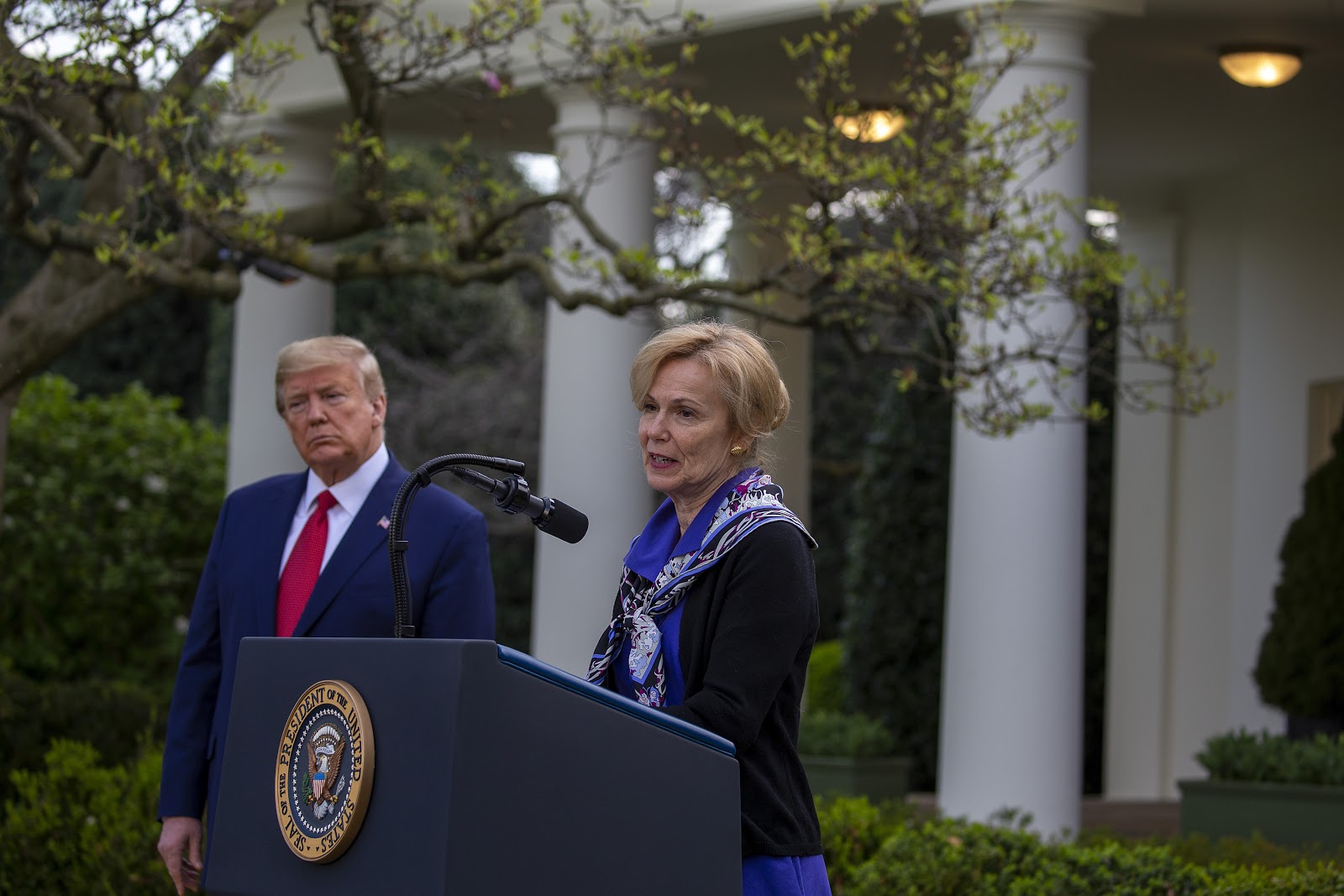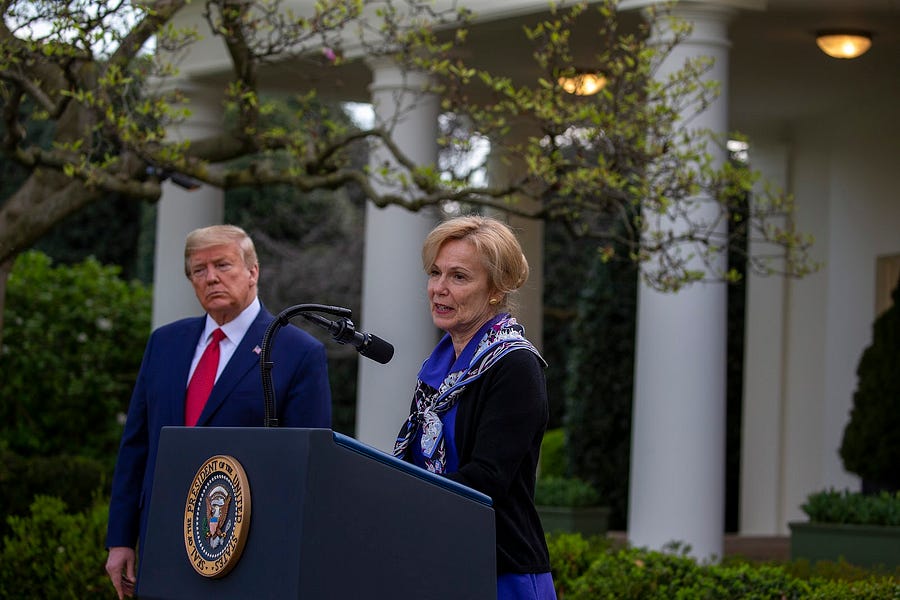Happy Monday. Let’s get right to it.
Quick Hits: Today’s Top Stories
-
As of Sunday night, there are now 142,106 confirmed cases of COVID-19 in the United States (a 65.6 percent increase over the weekend) and 2,479 deaths (a 91.3 percent increase over the weekend), according to the Johns Hopkins University COVID-19 Dashboard, leading to a mortality rate among confirmed cases of 1.7 percent (the true mortality rate is difficult to calculate due to incomplete testing regimens). Of 831,351 coronavirus tests conducted in the United States, 16.7 percent have come back positive, per the COVID Tracking Project, a separate dataset with slightly different topline numbers.
-
The House passed—and President Trump signed—the Coronavirus Aid, Relief, and Economic Security (CARES) Act into law on Friday afternoon. Kentucky GOP Rep. Thomas Massie insisted upon a congressional quorum—rather than unanimous consent—to pass the legislation, forcing hundreds of lawmakers to travel back to D.C. against public health warnings and incurring the wrath of leaders in both parties.
-
President Trump invoked the Defense Production Act on Friday to “require General Motors to accept, perform, and prioritize federal contracts for ventilators,” saying in a statement: “Our fight against the virus is too urgent to allow the give-and-take of the contracting process to continue to run its normal course.”
-
U.K. Prime Minister Boris Johnson became the first world leader to test positive for the coronavirus, announcing his results on Friday. “I am now self-isolating,” he said, “but I will continue to lead the government’s response via video-conference as we fight this virus. Together we will beat this.”
-
Civil rights leader Rev. Joseph Lowery—who helped organize the Montgomery bus boycott in 1955 and more than 50 years later gave the benediction at President Obama’s inauguration—passed away at 98 on Friday. Tom Coburn—the longtime senator (and doctor) from Oklahoma who retired from Congress in 2015—succumbed to prostate cancer over the weekend at the age of 72.
-
The FDA approved a point-of-care coronavirus test from Abbott Labs on Friday that delivers positive results in as little as five minutes. Abbott expects the tests to be available this week and is expecting to soon produce 50,000 a day.
‘The Better You Do, the Faster This Whole Nightmare Will End’

Standing alone on an elevated stage in the Rose Garden on Sunday—reporters and members of his Coronavirus Task Force scattered around him—President Trump came face-to-face with the stark reality of our situation: The worst is yet to come.
“The modeling estimates that the peak in death rate is likely to hit in two weeks,” he said. “Nothing would be worse than declaring victory before the victory is won. That would be the greatest loss of all. Therefore, the next two weeks, and during this period, it’s very important everyone strongly follow the guidelines … The better you do, the faster this whole nightmare will end. Therefore, we will be extending our guidelines to April 30.”
“Our guidelines” refers to Trump’s “15 Days to Slow the Spread” initiative, which implores Americans to avoid gatherings of more than 10 people, work from home if possible, and refrain from nonessential travel. In other words, Trump’s aspiration of opening up the economy on Easter will not materialize (though that power resides with state governors, many of whom would not follow Trump’s lead if the data dictated otherwise). And according to public health officials, that’s a very good thing.
“Aggressive social distancing measures should stay in place until there’s a sustained reduction in the number of #COVID19 cases,” tweeted former Food and Drug Administration Commissioner Scott Gottlieb. “As this becomes a national epidemic, we must take a uniform approach to these measures across the country. Every city is at risk.”
“The decision to extend this mitigation process until the end of April, I think was a wise and prudent decision,” Dr. Anthony Fauci—director of the National Institute of Allergy and Infectious Diseases—told reporters Sunday. “Dr. [Deborah] Birx and I spent a considerable amount of time going over all the data, why we felt this was a best choice of us, and the president accepted it.”
In an interview with CNN’s Jake Tapper earlier in the day, Fauci had projected between 100,000 and 200,000 COVID-19 deaths in the United States and “millions” of cases nationwide, though he made clear pandemics are difficult to model and predictions “can so easily be wrong and mislead people.”
A modeling number even more staggering—2.2 million—seemed to capture Trump’s attention. “What would happen if we did nothing, did nothing, just rode it out?” he said many people—including himself—were asking. “Think of the number, potentially 2.2 million people if we did nothing, if we didn’t do the distancing, if we didn’t do all the things we are doing. … So you are talking about 2.2 million deaths, 2.2 million people from this. And so, if we can hold that down, as we are saying, to 100,000, it is a horrible number, maybe even less, but to 100,000, so we have between 100,000 and 200,000, we all together have done a very good job.”
Sunday’s press conference—which featured several mutually beneficial sparring matches between reporters and Trump from which we will spare you—capped a wild weekend for the president.
On Friday, he took on two Democratic governors—Jay Inslee of Washington and Gretchen Whitmer of Michigan—for being insufficiently “appreciative” of his administration’s efforts during this crisis, informing reporters he has told Vice President Mike Pence not to call either of them. “You know what I say? If they don’t treat you right, I don’t call,” he declared, adding that Pence is “a different type of person” and calls them anyway.
On Saturday, he floated—via tweet—the possibility of quarantining the “hot spots” of New York, New Jersey, and Connecticut from the rest of the country—inducing widespread panic—before settling on a 14-day travel advisory for the states instead.
On Sunday afternoon, amid reports of a rapidly growing number of infections and deaths, Trump posted a series of tweets touting the TV ratings his nightly press briefings have garnered, citing a New York Times piece comparing the figures to those of The Bachelor and Monday Night Football. “The Lamestream Media is going CRAZY. ‘Trump is reaching too many people, we must stop him.’ said one lunatic.” It’s unclear which lunatic, if any, said that.
What a Return to Normal Could Look Like
As we’ve discussed in the past, one of the chief difficulties of balancing the public health dangers of the coronavirus outbreak against its economic risks has been our lack of agreed-upon inflection points: benchmarks for how much better the situation should become before each part of our normal lives can be safely resumed. As we begin to see real results flattening the curve of new infections this week and next, developing such standards is sure to become a larger and larger part of the national coronavirus conversation.
In light of that, we thought it’d be useful to break down one of the best strategic frameworks for that conversation we’ve seen put forward yet: the “Road Map to Reopening” released Sunday by an American Enterprise Institute team headed by the aforementioned Dr. Scott Gottlieb.
In Gottlieb’s reading, the country is still in “phase one” of our coronavirus response: the acute emergency lockdown designed to reduce dramatically new infections and to buy us time to accelerate operations to track and combat the virus. These draconian measures will need to continue for a while—but not necessarily for the period of many months that some experts have predicted would be necessary to fully freeze out the virus.
Long before the virus is truly eradicated or defeated, Gottlieb envisions the country moving, on a state-by-state basis, into a deeply cautious partial reopening: Most schools, universities, and businesses would resume, albeit with much stricter than usual hygiene and distance controls, while at-risk populations continued to self-isolate and social gatherings remained limited.
But how will a state know when it’s ready? Under the report’s criteria, when it has achieved all four of these objectives, quoted verbatim:
-
A sustained reduction in cases for at least 14 days;
-
Hospitals in the state are safely able to treat all patients requiring hospitalization without resorting to crisis standards of care;
-
The state is able to test all people with COVID-19 symptoms; and
-
The state is able to conduct active monitoring of confirmed cases and their contacts.
After completing these first two phases, the final two involve ending the current crisis by discovering workable therapeutics or developing a safe and effective vaccine and strengthening our national defenses against similar threats in the future.
There are a few key points here. First, the phase two objectives are, unfortunately, not anything any state is likely to meet anytime extremely soon—certainly not before the April 30 date President Trump has begun to talk of now. Unlike much of the conversation that has taken place around reopening in recent weeks, these objectives are not pegged to a specific date—rather, they’re benchmarks intended to be adopted now that would give states specific goals to work toward in getting the virus sufficiently under control to allow their economies to begin a restart.
Second, these guidelines are designed, in accordance with the constitutional delegation of such powers, to be implemented and exercised at the discretion of individual states. The report, however, stresses that decentralized authority should not mean decentralized planning in a regional and national crisis like this: Coordinating a plan such as this is a task that necessarily falls to the White House. In the weeks ahead, President Trump’s ability to maintain a working relationship with all 50 of the nation’s governors will be of the utmost importance.
Don’t Take Those Chinese Coronavirus Numbers at Face Value
Last Thursday, the United States overtook Italy’s and China’s reported coronavirus case numbers, becoming the first nation with more than 100,000 confirmed COVID-19 cases. Given the Chinese government’s behavior throughout the pandemic, however, there are reasons to be skeptical of the accuracy of the numbers Beijing is offering. After all, Chinese leaders covered up the virus early on, even silencing whistleblowers to prevent the international community from discovering what was going on, and have gone so far as to spread conspiracy theories that coronavirus originated in the United States and was spread to China by the U.S. military. There have also been multiple revisions to how coronavirus cases are counted, and earlier this month the country expelled American reporters from the New York Times, Wall Street Journal, and Washington Post. With all this considered, the Chinese government has earned this great skepticism.
While the government reports 2,535 coronavirus deaths in Wuhan, photos published by Chinese news outlet Caixin and data from the city’s civil affairs agency indicate that the numbers in Wuhan, and likely China at large, are much higher. Caixin’s pictures show thousands of urns being delivered to a single funeral home in Wuhan and Wuhan’s civil affairs agency reported 56,007 cremations in the fourth quarter of 2019, a number 1,583 higher than a year before. Bloomberg reports that families have to wait hours to collect the cremated remains of their loved ones.
Sen. Tom Cotton has been particularly critical of China’s coronavirus numbers, pointing out that the country abruptly ordered all movie theaters to close again after re-opening them, hardly consistent with the official message that the virus is under control.
In an interview with Fox News on Sunday, Sen. Cotton said, “The Chinese Communist Party is still lying” about coronavirus.
Further concerns over China’s accountability in reporting coronavirus cases has been raised over the nation’s relationship with the World Health Organization, in which China wields considerable influence. WHO has been criticized for being overly deferential to China by some health experts. On January 28, the director general of WHO praised “the commitment from top leadership [in China], and the transparency they have demonstrated” regarding coronavirus. It was already apparent at that point that the Chinese government had been suppressing information about the virus. A particularly awkward exchange between a Taiwanese reporter and WHO official over the weekend re-upped these concerns, as the WHO official attempted to evade responding to a question about Taiwan that might upset China.
Worth Your Time
-
It almost feels like old news by now, but it’s worth dwelling on: Things didn’t have to get this bad. This New York Times feature is a necessary look back at “the lost month” of February, in which bureaucracy, regulation, and failed leadership kept the U.S. from scaling up coronavirus testing to fit the nation’s needs as the virus crept silently up around us. It’s a nice complement to the piece we ran from from Alec Stapp on March 20, detailing the bureaucratic failures of early 2020.
-
Moving from the past to the present: This Wall Street Journal piece lays out the ways in which the decisions businesses make this upcoming week may end up being the most important of the entire crisis when it comes to how deeply the economy is damaged: With April bills coming due, “which obligations do they pay and which can they put off? How many employees can they afford to keep on the payroll? Can they get a break on rent?”
Presented Without Comment
Also Presented Without Comment
Also Also Presented Without Comment
Toeing the Company Line
-
David’s Sunday French Press is a meditation on our knowledge, understood all our lives but nearly always ignored, of our own mortality, and on the Christian theological concepts of “natural evil” and the effects on creation of the fall into sin: “‘Why did this happen to me?’ is a question that is often impossible to answer in isolation. … But why is this happening to us is a question we can answer. We are being attacked by a natural evil that inhabits a fallen world, an evil that human beings can confront and, God willing, control through His mercy and grace. But it’s also an evil that’s doomed (as all evil is doomed) by a savior who comes not just to grant individuals eternal life, but to remake and renew creation itself.”
-
Love listening to The Remnant, but tired of hearing from all those so-called guests? So is Jonah! (We kid, we kid.) Anyway, have we got a product for you: The latest episode is Jonah solo, in what we are told is “a second and more streamlined attempt at an audio G-File” consisting of “unique, free-flowing observations from Jonah’s mind.”
-
And if you missed it over the weekend, here’s something else Jonah’s been up to: Assembling a collaborative and definitive lineup of “movies for the politically literate,” from 1939’s Mr. Smith Goes to Washington up through 2006’s The Lives of Others—first sorted by the writer that recommended them, then by year and streaming platform. It’s a great list, and you can check it out here. (The discussion thread following the piece is one of our best to date and includes many additional great suggestions.)
Let Us Know
As U.S. coronavirus suppression efforts continue into their third week, many restaurants across the country are serving only takeout or are shuttered entirely—making that relaxing meal out even more appealing now that it’s forbidden. When you finally get the green light to eat out, where will you go and what will you order?
Reporting by Declan Garvey (@declanpgarvey), Andrew Egger (@EggerDC), Alec Dent (@Alec_Dent), Sarah Isgur (@whignewtons), and Steve Hayes (@stephenfhayes).
Photograph of Deborah Birx by Tasos Katopodis/Getty Images.







Please note that we at The Dispatch hold ourselves, our work, and our commenters to a higher standard than other places on the internet. We welcome comments that foster genuine debate or discussion—including comments critical of us or our work—but responses that include ad hominem attacks on fellow Dispatch members or are intended to stoke fear and anger may be moderated.